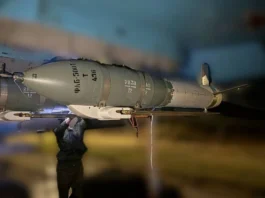Russian President Vladimir Putin says the recent “Oreshnik” missile strike on Yuzhmash on November 21 was a response to the US’s authorization to Ukraine to use long-range missiles against Russian territory. To intercept a hypersonic missile from Russia, Ukraine must initiate a salvo discharge of all 32 launchers of the Patriot-like air defense system, as per the Kiel Report. But Ukraine says the chances of hypersonic missile interception is just 25%. This is in addition to the routine nocturnal salvos that Russia has been launching on Ukraine on a nearly daily basis with non-hypersonic missiles.
This underscores a broader challenge currently facing the United States military: the rapidly depleting offensive and defensive missile stockpiles in numerous global conflict zones.
Chief Admiral Sam Paparo of the US Indo-Pacific Command explicitly acknowledged the strain on the US air defense missile reserves. He candidly acknowledged that the deployment of Patriot systems and air-to-air missiles was undermining the country’s strategic reserves. Military analysts have reiterated these concerns, noting that the current industrial base cannot keep up with the delivery of armaments to Israel and Ukraine.
This conclusion is not difficult to arrive at. According to official data, the annual production of Patriot PAC-2/PAC-3 missiles by Lockheed Martin and Raytheon is expected to reach approximately 740 by 2025, with the potential for an increase to 1,100 missiles by 2027.
The inability to provide sufficient air defense interceptors has significantly impacted Ukraine’s defensive capabilities, making the situation particularly critical. Russia has been able to exploit the missile shortage to target and destroy critical military objectives and infrastructure with relative ease.
The Ukrainian conflict is not the only issue. The US Navy has employed substantial missile resources in a variety of operations. By February 1, 2024, at least 100 Standard Series missiles had been deployed in the Red Sea alone. A recent report emphasized the substantial munitions expenditure of the USS Dwight D. Eisenhower carrier strike group. This expenditure included 155 Standard Series missiles, 135 Tomahawk cruise missiles, 60 air-to-air missiles, and 420 air-to-ground munitions.
The Heritage Foundation’s analysis reveals the stark reality of US missile inventories. The Pentagon had acquired approximately 12,000 Standard Missile-2s, 400 Standard Missile-3s, 1,500 Standard Missile-6s, and 9,000 Tomahawk Land Attack Missiles before 2023. Nevertheless, the US Navy has already spent a minimum of 2,800 Standard Missiles and 2,900 Tomahawks, excluding 2024 expenditures.
Tomahawk missiles, which are essential for deep strikes in a variety of global theaters, are particularly concerning. The United States stockpiles only contained approximately 4,000 Tomahawks by 2020, and production has increased by only 250 units since then. A single day of strikes on Houthi targets in Yemen resulted in the launch of over 80 Tomahawks, underscoring the unsustainable consumption rate. In light of the Oreshnik strike, Ukraine is apparently requesting these missiles, according to reports.
Analysts from the Center for Strategic and International Studies (CSIS) warn of even more significant implications. In the event of a large-scale conflict, the defense industrial base of the United States is incapable of expanding rapidly. The ongoing conflict in Ukraine has starkly demonstrated that modern warfare is fundamentally an industrial endeavor, necessitating robust and adaptable production capabilities.
Military columnists warn that the proxy conflict with Russia has already depleted substantial resources. They caution that a prospective military conflict with China could result in an exponential increase in missile consumption, which would exceed the current expenditure levels in the Middle East.
The fractures in Washington’s military-industrial foundation are becoming more apparent as it continues to participate in numerous global conflicts. There is currently significant doubt about Washington’s capacity to maintain extended military engagements, as the shrinking missile stockpiles outpace their replenishment rate.
Previously, Russia was the subject of propaganda regarding the depletion of its missile reserves. Nevertheless, Russia continues to launch missiles at Ukraine, with an increasing frequency of salvos. The Russian President is explicit about the introduction of new hypersonic missile types. In addition to missile exercises aimed at Taiwan, China has not yet fired any missiles. The nation maintains a diverse and extensive missile arsenal, which includes hypersonic projectiles.
The US is unlikely to receive any assistance in this sector from its partners in the near or mid-term. While Europe is making strides in improving its missile capabilities; it is confronted with obstacles regarding technological integration and coordination. Consequently, even though Europe is making progress in missile production, it may not be able to match Russia’s imminent output or aggressive strategy in the near term.
US military strategists and policymakers face a critical challenge. The United States’ preparedness for potential future global confrontations is at risk due to the rapid depletion of missile arsenals, which not only affects current conflict zones but also raises significant concerns.






